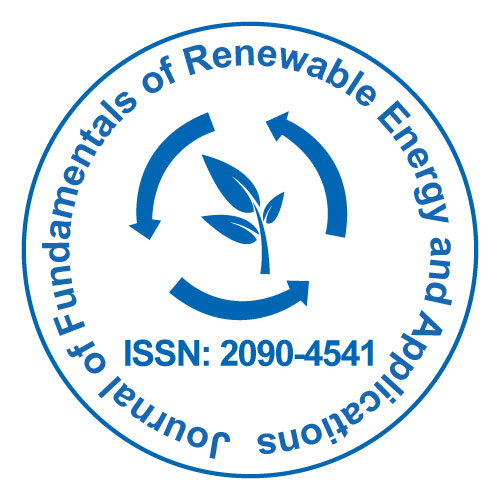
Journal of Fundamentals of Renewable Energy and Applications
Open Access
ISSN: 2090-4541

ISSN: 2090-4541
Opinion Article - (2024)Volume 14, Issue 4
The world must quickly move away from fossil fuels and toward cleaner, more sustainable energy sources as the threat posed by climate change grows. Geothermal energy is one of the renewable energy sources that is attracting the most attention because of its enormous potential to support global decarbonization initiatives. Geothermal energy is a dependable and low-carbon substitute for conventional energy sources by using the heat from beneath the Earth's surface to produce power or give direct heating. Geothermal energy has the potential to significantly contribute to the reduction of greenhouse gas emissions and the achievement of global climate goals with the correct investments and advancements.
Geothermal energy is typically considered as one of the most reliable and consistent kinds of renewable energy. Geothermal energy is available around-the-clock, in contrast to wind and solar electricity, which are sporadic and dependent on the weather. The Earth is a very reliable energy source because of its abundant and steady interior heat. Geothermal power plants produce electricity by harnessing heat from underground steam or hot water reservoirs. An extra benefit in terms of efficiency is that geothermal energy can occasionally be used directly to heat structures or industrial operations. Geothermal energy has the potential to propel decarbonization by displacing energy sources that rely on fossil fuels. One of the main causes of the world's greenhouse gas emissions is conventional electricity generation, particularly that which comes from coal, oil, and natural gas. Countries can drastically lower their carbon footprints by converting to geothermal energy for the production of electricity. One of the cleanest energy sources is geothermal power plants, which emit little or no pollutants. When compared to conventional power plants, geothermal facilities have far lower overall emissions, even when they employ fossil fuels for backup generation.
Geothermal energy can assist decarbonize hard-to-electrify industries, such industrial heating, in addition to producing sustainable electricity. A lot of heat is needed for many industrial operations, such as the production of metal, cement, and food. Fossil fuels are burned in these industries' traditional heating systems, which results in high emissions. On the other hand, geothermal energy can offer a direct source of heat that emits no carbon. Industries can significantly cut emissions and their overall carbon intensity by switching to geothermal heating systems from fossil fuel-based ones. Additionally, geothermal energy has the potential to lower transportation-related emissions. Even though many people believe that Electric Vehicles (EVs) will play a significant role in transportation in the future, EV manufacturing and charging still produce emissions if they are powered by fossil fuels. EVs can be charged with clean, renewable energy by incorporating geothermal energy into the electrical grid, which significantly lowers the transportation sector's carbon footprint. Furthermore, the production of lowcarbon hydrogen from geothermal energy has the potential to decarbonize heavy transportation and other challenging industries.
Geothermal energy has enormous global potential. Because of its geological activity, nations along the "Ring of Fire," including the United States, Iceland, and Indonesia, have an abundance of geothermal resources. These areas are increasing their geothermal capacity and currently have geothermal power plants operating. But geothermal energy isn't just found in places with volcanoes. Geothermal energy can now be used in areas that were previously unsuitable for conventional geothermal power generation thanks to recent developments in the field, such as Enhanced Geothermal Systems (EGS). EGS technology can release geothermal resources in a much wider range of locales by fracturing rocks and drilling deep into the Earth's crust to build artificial reservoirs. There are still obstacles in the way of fully utilizing geothermal energy, despite its potential. The high initial cost of building geothermal power facilities is one of the main challenges. Drilling is a costly and technically complex procedure that entails penetrating deep into the Earth's crust. However, a geothermal plant is a very cost-effective energy source over the long term due to its extended lifespan and extremely low operating expenses after it is constructed. The cost of geothermal energy is anticipated to drop as economies of scale and technological advancements make it more affordable for a wider range of nations and sectors.
Citation: George M (2024). Geothermal Energy and its Potential to Drive Global Decarbonization. J Fundam Renewable Energy Appl. 14:363.
Received: 29-Nov-2024, Manuscript No. JFRA-24-36233; Editor assigned: 02-Dec-2024, Pre QC No. JFRA-24-36233 (PQ); Reviewed: 16-Dec-2024, QC No. JFRA-24-36233; Revised: 23-Dec-2024, Manuscript No. JFRA-24-36233 (R); Published: 30-Dec-2024 , DOI: 10.35248/2090-4541.24.14.363
Copyright: © 2024 George M. This is an open-access article distributed under the terms of the Creative Commons Attribution License, which permits unrestricted use, distribution and reproduction in any medium, provided the original author and source are credited.